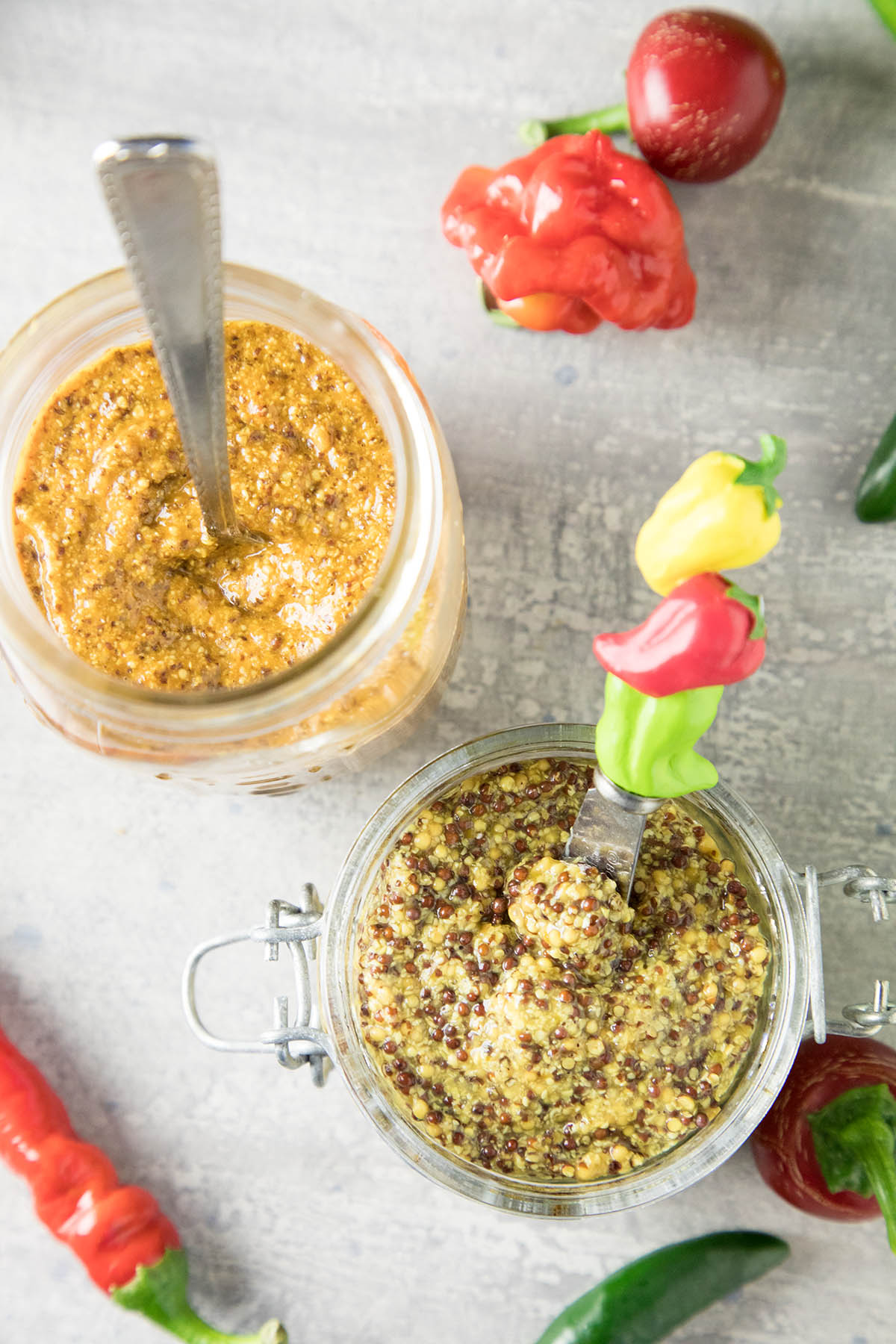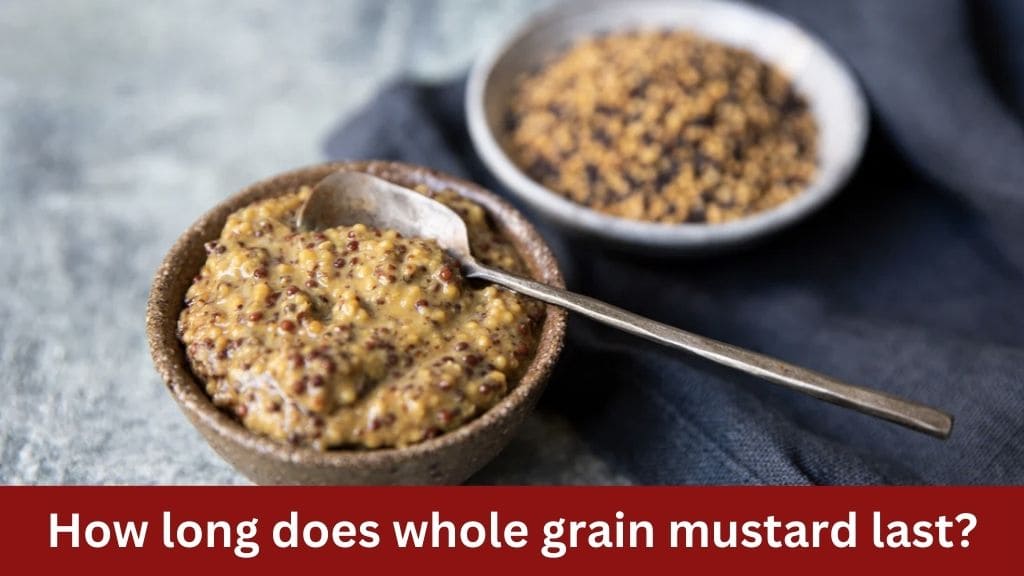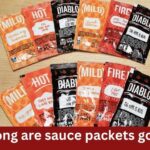Mustard enthusiasts often find themselves pondering the longevity of their favorite condiment, especially when it comes to whole grain mustard. Known for its robust flavor and grainy texture, whole grain mustard holds a special place in the culinary world. But how long does it last? In this comprehensive guide, we’ll delve into the shelf life of whole grain mustard, storage tips to maintain its freshness, factors influencing its longevity, and much more.
Understanding Whole Grain Mustard

Flavor Profile
The flavor of whole grain mustard is robust, tangy, and slightly spicy, with a depth that sets it apart from smoother mustard varieties. This bold taste comes from the combination of mustard seeds, vinegar, and other seasonings used in its preparation. The presence of whole or partially crushed mustard seeds adds a delightful crunch and bursts of flavor, making whole grain mustard a favorite among those who appreciate complex taste profiles.
Texture
One of the most notable features of whole grain mustard is its coarse texture, which is a result of the intact mustard seeds suspended in the condiment. When spread or used in dishes, these whole seeds provide a satisfying crunch and a rustic appearance that adds visual appeal to meals. The texture of whole grain mustard makes it ideal for use as a topping, dip, or ingredient in various recipes where a bit of texture is desired.
Culinary Versatility
Whole grain mustard’s bold flavor and unique texture make it a versatile ingredient in the kitchen. It can be used in a wide range of dishes, including sandwiches, salads, marinades, dressings, and sauces. Whether used as a condiment for meats and sandwiches or incorporated into recipes to add depth and complexity, whole grain mustard adds a distinct character to dishes and elevates their flavor profile.
Pairing Recommendations
The robust flavor of whole grain mustard pairs well with a variety of foods, both savory and sweet. It complements meats such as pork, beef, and poultry, adding a tangy kick to grilled or roasted dishes. Whole grain mustard also pairs beautifully with cheeses, charcuterie, and crusty bread, making it a popular choice for cheese boards and appetizers. Additionally, its slightly spicy and acidic notes make it an excellent ingredient in salad dressings, vinaigrettes, and dips, where it can cut through rich or creamy flavors and add brightness to the dish.
Homemade Variations
While whole grain mustard is readily available in stores, many culinary enthusiasts enjoy making their own homemade versions. Homemade whole grain mustard allows for customization of flavors and ingredients, giving cooks the opportunity to experiment with different mustard seeds, vinegars, and seasonings to create a condiment that suits their taste preferences. Making homemade whole grain mustard is relatively simple and requires only a few basic ingredients, making it an accessible and rewarding culinary project for home cooks.
Shelf Life of Whole Grain Mustard

Storage Conditions
Proper storage is crucial for maintaining the freshness and flavor of whole grain mustard. When stored correctly, whole grain mustard can last for extended periods without compromising its quality. Here are some key storage considerations:
- Refrigeration: Once opened, whole grain mustard should be refrigerated to extend its shelf life. The cool and stable temperature of the refrigerator helps slow down the degradation process, preserving the mustard’s taste and texture.
- Airtight Containers: Storing whole grain mustard in airtight containers helps prevent exposure to air, moisture, and contaminants that can accelerate spoilage. It’s essential to ensure that the container is tightly sealed after each use to maintain freshness.
- Dark, Cool Environment: Whole grain mustard should be stored in a dark, cool environment away from direct sunlight or heat sources. Exposure to light and high temperatures can degrade the quality of the mustard and shorten its shelf life.
Packaging Integrity
The integrity of the packaging plays a significant role in determining the shelf life of whole grain mustard. A tightly sealed container helps prevent the entry of contaminants and maintains the freshness of the mustard. It’s essential to inspect the packaging for any signs of damage or compromise before purchasing or storing whole grain mustard.
Presence of Natural Preservatives
Whole grain mustard contains natural preservatives, such as vinegar and spices, which contribute to its extended shelf life. These preservatives help inhibit the growth of bacteria and fungi that can cause spoilage. Additionally, the acidity of mustard further enhances its preservation properties, making it less susceptible to degradation over time.
Factors Affecting Shelf Life
:max_bytes(150000):strip_icc()/dijon-style-mustard-recipe-996034_10-5b4a9dc446e0fb0054fd4b8f.jpg)
Storage Conditions
Proper storage conditions play a significant role in determining the shelf life of whole grain mustard. Factors such as temperature, humidity, and exposure to light can affect the quality of the mustard over time.
- Temperature: Fluctuations in temperature can accelerate the degradation of whole grain mustard. Refrigeration is recommended to maintain a stable temperature and slow down the oxidation process, which can cause the mustard to lose its flavor and freshness.
- Humidity: High humidity levels can promote the growth of mold and bacteria, leading to spoilage of the mustard. Storing the mustard in a dry environment helps prevent moisture buildup and extends its shelf life.
- Light Exposure: Exposure to light, especially sunlight, can degrade the quality of whole grain mustard. Ultraviolet (UV) radiation can cause the mustard to lose its color, flavor, and nutritional value. Storing the mustard in a dark environment, such as a pantry or refrigerator, helps preserve its freshness and appearance.
Packaging Integrity
The integrity of the packaging is essential for preserving the quality of whole grain mustard and extending its shelf life. Airtight containers help prevent air and moisture from entering, which can cause the mustard to spoil more quickly.
- Seal Strength: A tight seal on the container helps maintain the freshness of the mustard by preventing the entry of air and contaminants. It’s essential to ensure that the lid is securely closed after each use to prolong the shelf life of the mustard.
- Material Quality: The material of the packaging can also impact the shelf life of whole grain mustard. Non-reactive materials, such as glass or food-grade plastic, are preferable as they do not interact with the mustard and affect its flavor or quality.
Presence of Contaminants
Contaminants can introduce bacteria and other microorganisms that can spoil the mustard and shorten its shelf life. It’s crucial to minimize the risk of contamination by practicing proper hygiene and handling procedures.
- Cleanliness: Using clean utensils and containers when handling whole grain mustard helps prevent the introduction of contaminants. It’s essential to wash utensils thoroughly before each use to ensure they are free from dirt, bacteria, and other impurities.
- Avoiding Cross-Contamination: Cross-contamination can occur when utensils or surfaces come into contact with raw or contaminated ingredients. It’s essential to use separate utensils and surfaces for handling mustard to prevent the transfer of harmful bacteria.
Signs of Spoilage and Food Safety

Visual and Textural Changes
Spoiled mustard often exhibits noticeable visual and textural changes, indicating that it has undergone degradation or contamination. These changes can include:
- Color: A dull, faded, or brownish hue replacing the bright, vibrant color of fresh mustard is a sign of spoilage. Any discoloration, especially if accompanied by mold growth, indicates that the mustard should not be consumed.
- Mold: The presence of mold on the surface of the mustard is a clear indication of spoilage. Mold growth can occur when the mustard is exposed to moisture or contaminants, making it unsafe for consumption.
- Separation: While some separation of ingredients is normal in whole grain mustard, excessive separation can indicate degradation. If the mustard appears watery or has visible layers of liquid and solids, it may have spoiled.
Smell and Taste Alterations
The sensory qualities of mustard, particularly its smell and taste, can provide valuable clues about its freshness and safety. Spoiled mustard may exhibit the following smell and taste alterations:
- Smell: An off or sour smell that is different from the mustard’s typical tangy aroma is a telltale sign of spoilage. If the mustard emits a foul or unpleasant odor, it should not be consumed.
- Taste: Any noticeable deviation from the original flavor of the mustard, particularly an excessively bitter, sour, or otherwise off taste, should be considered a warning sign. Spoiled mustard may taste rancid or unpleasant, indicating that it is no longer safe to eat.
Safety Considerations
Ensuring food safety when it comes to whole grain mustard involves practicing proper hygiene and storage procedures. Here are some safety considerations to keep in mind:
- Cleanliness: Always use clean utensils and containers when handling mustard to prevent contamination. Wash utensils thoroughly before each use to remove any dirt, bacteria, or other impurities.
- Storage: Store whole grain mustard in a cool, dark place away from direct sunlight, heat sources, and moisture. Refrigeration is recommended once the mustard is opened to extend its shelf life and preserve its freshness.
- Hygiene: Practice good hygiene habits when preparing and serving mustard-containing dishes. Wash hands thoroughly before handling food and avoid cross-contamination by using separate utensils and surfaces for raw and cooked ingredients.
Maximizing Mustard Quality and Flavor

Preservation Techniques
Proper storage is paramount for preserving the freshness and flavor of whole grain mustard. Here are some preservation techniques to consider:
- Storage Location and Conditions: Before opening, store whole grain mustard in a cool, dark place, such as a pantry, to maintain its quality. Once opened, refrigerate the mustard tightly covered to prevent air exposure and maintain its pungency.
- Containers: Use opaque containers to shield the mustard from light, which can degrade its quality over time. Airtight containers help prevent air and moisture from entering, preserving the mustard’s freshness and flavor.
- Shelf Life: Whole grain mustard typically has a shorter shelf life once opened compared to unopened mustard. It’s essential to adhere to recommended storage guidelines and consume opened mustard within the recommended timeframe for optimal quality.
Using Mustard in Cooking
Incorporating whole grain mustard into recipes can enhance the flavor and depth of various dishes. Here are some tips for using mustard in cooking:
- Flavor Enhancement: Whole grain mustard brings a robust, pungent flavor to dishes and can be used to enhance the taste of sauces, dressings, marinades, and glazes.
- Integration into Recipes: Follow recipe instructions when incorporating mustard into dishes to ensure the ingredients complement each other and the mustard’s flavor is maximized.
- Versatility: Experiment with different culinary applications for mustard, including sandwiches, salads, meats, and appetizers, to explore its versatility and add complexity to your dishes.
Tips for Homemade Mustard Preparation
For those who enjoy homemade condiments, making mustard at home allows for customization and control over ingredients. Here are some tips for preparing homemade mustard:
- Ingredient Selection and Handling: Choose high-quality mustard seeds and other ingredients to ensure the best flavor and quality. Proper handling and storage of ingredients are crucial for maintaining freshness.
- Storage Recommendations: Store homemade mustard in airtight containers in a cool, dark place to preserve its flavor and quality. Refrigeration can help extend its shelf life and maintain its pungency.
- Monitoring Freshness: Regularly check homemade mustard for any signs of spoilage, such as changes in color, texture, or smell. Discard any mustard that shows signs of deterioration to ensure food safety.
Conclusion
The shelf life of whole grain mustard depends on various factors such as storage conditions, packaging integrity, and proper handling. By understanding these factors and following best practices for storage and usage, one can prolong the freshness and quality of whole grain mustard, ensuring it remains a flavorful addition to culinary creations for an extended period. Whether used as a condiment, ingredient, or homemade creation, whole grain mustard adds depth and character to dishes, making it a staple in kitchens around the world.





